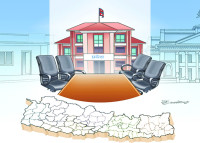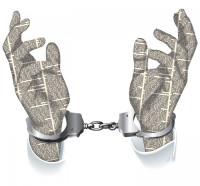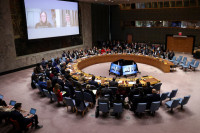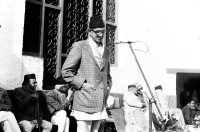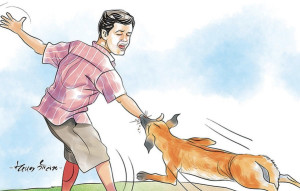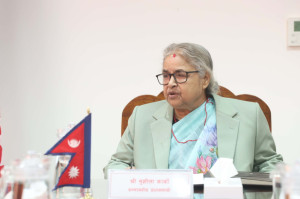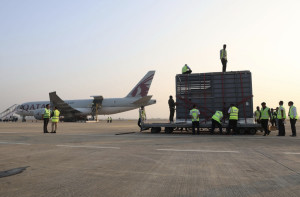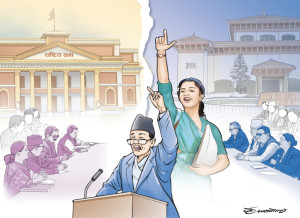Columns
Dahal’s hubris, inflation and misgovernance
Nepal’s remittance quickly travels back overseas due to our failure to utilise it in the productive sector..jpg&w=900&height=601)
Jagadish Prasad Bist
Prime Minister Pushpa Kamal Dahal, in his recent address to the country, acknowledged his government’s failure to meet public expectations and pledged not to repeat the mistake. However, history doesn’t corroborate his claims. He said the same thing during his first stint as prime minister in 2008, again in 2016, once more in 2022 and then reiterated the same recently. Be it in the past or the present, he has failed to deliver on economic agendas and maintain transparency in governance.
Look no further to understand the Dahal government’s failure to resolve the gold smuggling and Bhutanese refugee cases, in which members of his party, coalition and even the opposition have been involved. He can neither come strongly against the mafia and maintain transparency nor does he want to do so as the fingers start pointing towards him and his ilk once the investigation goes deeper. So, his recurrent promise to bring about changes is just a rhetorical exercise. As the adage goes, “Insanity is doing the same thing over and over again and expecting different results.”
Economy in crisis
Things are even worse on the economic front. The prime minister cherry-picked some macroeconomic indicators from the Nepal Rastra Bank’s (NRB) recent quarterly report and claimed inflation was under control, imports had decreased, remittances had increased, and the foreign exchange reserve was better than when he had started. He also said his government was trying to reduce interest rates to stimulate the economy and tried to paint a good picture of the economy. However, in reality, the economy is neither doing well nor showing any sign of improving soon.
To understand the economic situation, one must first review the typical indicators every government has been cherry-picking for years to justify their performances. Many politically engaged economists emulate the same. Two very famous yet dangerous indicators are remittance and foreign exchange reserve. NRB’s quarterly report for mid-November 2023 shows that remittance has increased by 26.4 percent and NRB’s reserve by 10.8 percent in the last four months. Like the previous governments, the incumbent prime minister highlighted this data as his achievement and an indicator of a well-functioning economy.
Irony of rising remittance
However, this fact is anything but an indicator of a healthy economy. If at all, this is just one side of the coin, with the other side being more dangerous as remittance comes at the cost of productive human capital. NRB’s report shows that in the past four months, 137,475 new migrations and 68,841 remigrations of workers have been recorded, reducing involvement in the productive sector and triggering dependency on foreign employment.
The irony lies in NRB’s statement: "The foreign exchange reserves of the banking sector are sufficient to cover the prospective merchandise imports of 13.6 months.” This paints the picture of an ignored economy. Even though the country receives a huge amount of remittance, it quickly travels back overseas, triggering Dutch Disease—failure to utilise remittance in the productive sector. The World Bank indicators also show that manufacturing activities have been reduced by 2 percent this year and expect the economy to grow by only 1.9 percent in 2023 and 3.9 percent in 2024.
Moreover, current indicators of the NRB suggest that credit to the private sector has increased only by 4.4 percent and deposits by 14 percent—meaning that the country’s productive sector is losing momentum year by year. World Bank Development Indicators have shown that in the last 10 years, Nepal’s average gross private capital formation, indicating private investment, is about 23 percent, while household consumption is above 80 percent of GDP. All these facts are more than sufficient to argue that the economy is not in a good state.
Prime Minister Dahal, in his address, said that inflation was under control by citing the NRB’s recent calculation of 5.4 percent CPI-based inflation. He also stated that his government was striving to reduce interest rates in a quest to reduce inflation, which ironically is against the elementary economic principle.
Understanding the story behind 5.4 percent inflation and its credibility is vital. NRB’s macroeconomic indicators demonstrate that the price level is about 5.4 percent more than it was during the same period last year. However, this calculation indicates the real inflation time and ignores the same in previous quarters of 2023, which was above 7 percent. Moreover, to understand the broader picture of inflation, we must recall the situation of 2020 when Covid-19 crippled the supply side of the economy, and inflation started soaring worldwide, reaching near double digits. Since then, it has been increasing well above 8 percent. The NRB report also shows that the price level of the products that directly hit the household is as high as 34 percent: Cereal and grains (12 percent), pulses (9 percent), sugar and fruit (14 percent) and spices (34 percent). This does not even include increased fuel prices, which increased by more than 100 percent in the last few years.
Misfire in interest rates
Similarly, the Dahal-led government was under the wrong impression from the beginning and wanted to decrease interest rates during inflation. At first glance, it seems reasonable for the government to control rising interest rates when the economy is slowing down. But economics is more complex than that. It would be better to increase interest rates to weaken public confidence in reckless spending and control demand and price, especially when inflation seems unstoppable. Although this may decrease economic activities in the short run, it will cool down the price level in the long run.
Therefore, at the current inflation rate of above 7 percent, loosening monetary rates will prove bad in the long run. In fact, NRB’s survey on inflation expectations also shows at least 12 percent expected inflation in 2023. So Dahal’s quest to stimulate the economy by decreasing interest rates at the present condition is irrational and dangerous—it will permanently affect the long-run price level. The sole purpose of policymaking during the inflationary period is to reduce the bleeding of money and consumption. However, lower interest rates give confidence to increase spending and worsen the already increased price level.
How long should the economy hold on to higher interest rates? There isn’t any straight answer. It also partially depends on the nature of the economy. For instance, in Nepal, where significant investment activities are either in the share market or real estate, which are risky alternatives, effects can be seen sooner as increasing interests start decreasing the demand and prices of real states and securities. Conversely, since Nepal imports almost everything, the price level is also partially dependent on the external spillover effect of inflation—predominantly Indian inflation.
We will have to wait and see until the price level returns to normal, as indicated by pre-inflationary levels or worsening economic activities. This is why central banks exist as the watchdogs of the economy. Looking at one-quarter of inflation alone while the overall average for the year is above 7 percent is insufficient. The government should leave the central bank alone to do its job in the economy's best interests.




 16.2°C Kathmandu
16.2°C Kathmandu.jpg)
